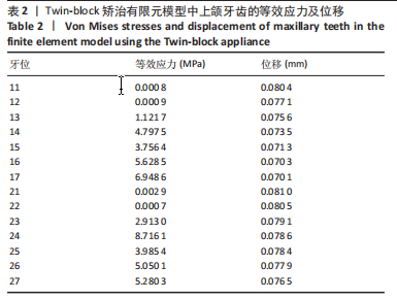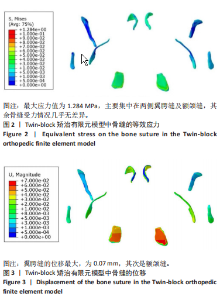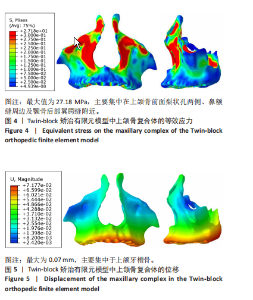Chinese Journal of Tissue Engineering Research ›› 2025, Vol. 29 ›› Issue (5): 881-887.doi: 10.12307/2025.287
Stress distribution on the maxilla when wearing the Twin-block appliance for Class II malocclusion
Li Shuai1, Liu Hua2, Shang Yonghui1, Liu Yicong3, Zhao Qihang1, Liu Wen2
- 1Dalian Medical University, Dalian 116000, Liaoning Province, China; 2Center of Stomatology, Qingdao Hospital of Rehabilitation University/Qingdao Municipal Hospital, Qingdao 266000, Shandong Province, China; 3Qingdao Grace Jiamei Dental Clinic of Laoshan District, Qingdao 266100, Shandong Province, China
-
Received:2024-01-19Revised:2024-03-12Online:2025-02-18Published:2024-06-01 -
Contact:Liu Wen, MD, Associate chief physician, Center of Stomatology, Qingdao Hospital of Rehabilitation University/Qingdao Municipal Hospital, Qingdao 266000, Shandong Province, China -
About author:Li Shuai, Master candidate, Physician, Dalian Medical University, Dalian 116000, Liaoning Province, China
CLC Number:
Cite this article
Li Shuai, Liu Hua, Shang Yonghui, Liu Yicong, Zhao Qihang, Liu Wen. Stress distribution on the maxilla when wearing the Twin-block appliance for Class II malocclusion[J]. Chinese Journal of Tissue Engineering Research, 2025, 29(5): 881-887.
share this article
Add to citation manager EndNote|Reference Manager|ProCite|BibTeX|RefWorks
| [1] COZZA P, BACCETTI T, FRANCHI L, et al. Mandibular changes produced by functional appliances in Class II malocclusion: a systematic review. Am J Orthod Dentofacial Orthop. 2006;129(5):599.e1-12; discussion e1-6. [2] ZYMPERDIKAS VF, KORETSI V, PAPAGEORGIOU SN, et al. Treatment effects of fixed functional appliances in patients with Class II malocclusion: a systematic review and meta-analysis. Eur J Orthod. 2016;38:113-126. [3] BACCETTI T, FRANCHI L, STAHL F. Comparison of 2 comprehensive Class II treatment protocols including the bonded Herbst and headgear appliances: a double-blind study of consecutively treated patients at puberty. Am J Orthod Dentofac Orthop. 2009; 135:698.e1-10; discussion 698. [4] BISHARA SE, ZIAJA RR. Functional appliances: a review. Am J Orthod Dentofacial Orthop. 1989;95:250-258. [5] MCNAMARA JA JR. Components of Class II malocclusion in children 8-10 years of age. Angle Orthod. 1981;51:177-202. [6] GIUNTINI V, VANGELISTI A, MASUCCI C, et al. Treatment effects produced by the Twin-block appliance vs the Forsus fatigue resistant device in growing Class II patients. Angle Orthod. 2015;85:784-789. [7] EHSANI S, NEBBE B, NORMANDO D, et al. Short-term treatment effects produced by the Twin-block appliance: a systematic review and meta-analysis. Eur J Orthod. 2015;37:170-176. [8] JAMILIAN A, SHOWKATBAKHSH R, AMIRI SS. Treatment effects of the R-appliance and Twin block in Class II Division 1 malocclusion. Eur J Orthod. 2011;33:354-358. [9] BASTIANI C, BELLINI-PEREIRA SA, ALIAGA-DEL CASTILLO A, et al. Twin-block and mandibular anterior repositioning appliances effects in Class II malocclusion correction. Am J Orthod Dentofacial Orthop. 2023;163(2):181-190. [10] VAN DER PLAS MC, JANSSEN KI, PANDIS N, et al. Twin block appliance with acrylic capping does not have a significant inhibitory effect on lower incisor proclination. Angle Orthod. 2017;87:513-518. [11] SARI Z, GOYENC Y, DORUK C, et al. Comparative evaluation of a new removable jasper Jumper functional appliance vs an activatorheadgear combination. Angle Orthod. 2003;73:286-293. [12] HANSEN K, PANCHERZ H, HÃGG U. Long-term effects of the Herbst appliance in relation to the treatment growth period: a cephalometric study. Eur J Orthod. 1991;13:471-481. [13] OZDILER O, ORHAN K, CESUR E, et al. Evaluation of temporomandibular joint, masticatory muscle, and brain cortex activity in patients treated by removable functional appliances: a prospective fMRI study. Dentomaxillofac Radiol. 2019;48(7):20190216. [14] LEE RT, KYI CS, MACK GJ. A controlled clinical trial of the effects of the Twin Block and Dynamax appliances on the hard and soft tissues. Eur J Orthod. 2007;29(3):272-282. [15] BUYUKCAVUS MH, KALE B. Skeletal and Dental Effects of Twin-Block Appliances in Patients Treated With or Without Expansion. Turk J Orthod. 2021;34(3):155-162. [16] MOUSA MA, ABDULLAH JY, JAMAYET NB, et al. Biomechanics in removable partial dentures: a literature review of FEA-based studies. BioMed Res Int. 2021;2021:5699962. [17] MEREMA BBJ, KRAEIMA J, GLAS HH, et al. Patient-specific finite element models of the human mandible: lack of consensus on current set-ups. Oral Dis. 2021;27:42-51. [18] NOWAK R, OLEJNIK A, GERBER H, et al. Comparison of tooth- and bone-borne appliances on the stress distributions and displacement patterns in the facial skeleton in surgically assisted rapid maxillary expansion-a finite element analysis (FEA) study. Materials (Basel). 2021;14:1152. [19] GAZZANI F, PAVONI C, GIANCOTTI A, et al. Facemask performance during maxillary protraction: a finite element analysis (FEA) evaluation of load and stress distribution on Delaire facemask. Prog Orthod. 2018;19:21. [20] SEONG EH, CHOI SH, KIM HJ, et al. Evaluation of the effects of miniscrew incorporation in palatal expanders for young adults using finite element analysis. Korean J Orthod. 2018;48(2):81-89. [21] GOMEZ JP, PEÑA FM, MARTÍNEZ V, et al. Initial force systems during bodily tooth movement with plastic aligners and composite attachments: A three-dimensional finite element analysis. Angle Orthod. 2015;85(3):454-460. [22] HARTONO N, SOEGIHARTO BM, WIDAYATI R. The difference of stress distribution of maxillary expansion using rapid maxillary expander (RME) and maxillary skeletal expander (MSE)-a finite element analysis. Prog Orthod. 2018;19(1):33. [23] HSU M, CHANG C. Application of finite element analysis in dentistry. In book: Finite Element Analysis, 2012:43-61. [24] 付雅丽.上颌快速扩弓及前方牵引作用下骨缝标识性颅面骨三维有限元研究[D].济南:山东大学,2008. [25] 沙焱,邓瑛,傅石雨,等.前方牵引下颅面复合体骨缝应力特征的三维有限元分析[J].上海口腔医学,2009,18(3):277-281. [26] CHATZIGIANNI A, KEILIG L, DUSCHNER H, et al. Comparative analysis of numerical and experimental data of orthodontic mini-implants. Eur J Orthod. 2011;33:468-475. [27] CHAUDHRY A, SIDHU MS, CHAUDHARY G, et al. Evaluation of stress changes in the mandible with a fixed functional appliance: a finite element study. Am J Orthod Dentofacial Orthop. 2015;147:226-234. [28] MARUO IT, MARUO H, SAGA AY, et al. Tridimensional finite element analysis of teeth movement induced by different headgear forces. Prog Orthod. 2016;17(1):18. [29] COZZANI M, SADRI D, NUCCI L, et al. The effect of Alexander, Gianelly, Roth, and MBT bracket systems on anterior retraction: a 3-dimensional finite element study. Clin Oral Investig. 2020;24:1351-1357. [30] PERILLO L, JAMILIAN A, SHAFIEYOON A, et al. Finite element analysis of miniscrew placement in mandibular alveolar bone with varied angulations. Eur J Orthod. 2015;37:56-59. [31] COZZANI M, NUCCI L, LUPINI D, et al. The ideal insertion angle after immediate loading in Jeil, Storm, and Thunder miniscrews: a 3DFEM study. Int Orthod. 2020;18:503-508. [32] ANDRE CB, RINO-NETO J, IARED W, et al. Stress distribution and displacement of three different types of micro-implant assisted rapid maxillary expansion (MARME): a three-dimensional finite element study. Prog Orthod. 2021;22(1):20. [33] COZZANI M, NUCCI L, LUPINI D, et al. Two different designs of mini-screw assisted maxillary expanders, using FEM to analyse stress distribution in craniofacial structures and anchor teeth. Int Orthod. 2022;20(1):100607. [34] MEIKLE MC. Remodeling the dentofacial skeleton: the biological basis of orthodontics and dentofacial orthopedics. J Dent Res. 2007;86(1): 12-24. [35] ZHANG Y, ZHENG X, ZHANG Q, et al. Clinical finite element analysis of mandibular displacement model treated with Twin-block appliance. Am J Orthod Dentofacial Orthop. 2023;164(3):395-405. [36] RAFFERTY KL, HERRING SW. Craniofacial sutures: morphology, growth, and in vivo masticatory strains. J Morphol. 1999;242(2):167-179. [37] HERRING SW, RAFFERTY KL. Cranial and facial sutures: functional loading in relation to growth and morphology// Biological mechanisms of tooth eruption, resorption and replacement by implants.Harvard Society for the Advancement of Orthodontics, 2000:269-276. [38] 刘畅.唇舌弓式前方牵引与种植体式前方牵引的三维有限元分析[D].长春:吉林大学,2010 [39] MILLS CM, MCCULLOCH KJ. Treatment effects of the twin block appliance: a cephalometric study. Am J Orthod Dentofacial Orthop. 1998;114(1):15-24. [40] SIDLAUSKAS A. The effects of the Twin-block appliance treatment on the skeletal and dentolaveolar changes in Class II Division 1 malocclusion. Medicina (Kaunas). 2005;41(5):392-400. [41] O’BRIEN K, WRIGHT J, CONBOY F, et al. Effectiveness of early orthodontic treatment with the Twin-block appliance: a multicenter, randomized, controlled trial. Part 1: Dental and skeletal effects. Am J Orthod Dentofacial Orthop. 2003;124(3):234-243; quiz 339. [42] CLARK WJ. Twin Block Technique-A functional orthopedic appliance system. Am J Orthod Dentofacial Orthop. 1988;78:1-18. [43] LUND DI, SANDLER PJ. The effects of Twin Blocks: A prospective controlled study. Am J Orthod Dentofacial Orthop. 1998;113(1): 104-110. [44] SCHAEFER AT , MCNAMARA JA JR , FRANCHI L, et al. Acephalometric comparison of treatment with the Twin-block and stainless steel crown Herbst appliances followed by fixed appliance therapy. Am J Orthod Dentofacial Orthop. 2004;126(1):7-15. [45] TANAKA EM, SATO S. Longitudinal alteration of the occlusal plane and development of different dentoskeletal frames during growth. Am J Orthod Dentofacial Ortho. 2008’134(5):602.e1-11; discussion-3. [46] CORO JC, VELASQUEZ RL, CORO IM, et al. Relationship of maxillary 3-dimensional posterior occlusal plane to mandibular spatial position and morphology. Am J Orthod Dentofacial Orthop. 2016;150(1): 140-152. |
| [1] | Li Mingzhe, Ye Xiangling, Wang Bing, Yu Xiang. Preparation and osteogenic properties of liquid crystal display light-cured polylactic acid scaffold loaded with nano-tantalum [J]. Chinese Journal of Tissue Engineering Research, 2025, 29(4): 670-677. |
| [2] | Xiao Fang, Huang Lei, Wang Lin. Magnetic nanomaterials and magnetic field effects accelerate bone injury repair [J]. Chinese Journal of Tissue Engineering Research, 2025, 29(4): 827-838. |
| [3] | Ran Yaqin, Chen Xi, Xie Yanne, Yuan Jun. Mechanism and potential application strategies of pyroptosis in breast cancer treatment [J]. Chinese Journal of Tissue Engineering Research, 2025, 29(36): 7880-7888. |
| [4] | Li Chen, Liu Ye, Ni Xindi, Zhang Yuang. Simulation analysis of real-time continuous stiffness in muscle fibers and tendons of the triceps surae during multi-joint movement [J]. Chinese Journal of Tissue Engineering Research, 2025, 29(35): 7529-7536. |
| [5] | Yang Bo, Pan Xinfang, Chang Liuhui, Ni Yong. Correlation of echocardiographic parameters with disability at 3 months after acute ischemic stroke [J]. Chinese Journal of Tissue Engineering Research, 2025, 29(35): 7544-7551. |
| [6] | Liu Xuan, Ding Yuqing, Xia Ruohan, Wang Xianwang, Hu Shujuan. Exercise prevention and treatment of insulin resistance: role and molecular mechanism of Keap1/nuclear factor erythroid2-related factor 2 signaling pathway [J]. Chinese Journal of Tissue Engineering Research, 2025, 29(35): 7578-7588. |
| [7] | Gong Yuehong, Wang Mengjun, Ren Hang, Zheng Hui, Sun Jiajia, Liu Junpeng, Zhang Fei, Yang Jianhua, Hu Junping. Machine learning combined with bioinformatics screening of key genes for pulmonary fibrosis associated with cellular autophagy and experimental validation [J]. Chinese Journal of Tissue Engineering Research, 2025, 29(35): 7679-7689. |
| [8] | Han Jie, Pan Chengzhen, Shang Yuzhi, Zhang Chi. Identification of immunodiagnostic biomarkers and drug screening for steroid-induced osteonecrosis of the femoral head [J]. Chinese Journal of Tissue Engineering Research, 2025, 29(35): 7690-7700. |
| [9] | Fang Yuan, Qian Zhiyong, He Yuanhada, Wang Haiyan, Sha Lirong, Li Xiaohe, Liu Jing, He Yachao, Zhang Kai, Temribagen. Mechanism of Mongolian medicine Echinops sphaerocephalus L. in proliferation and angiogenesis of vascular endothelial cells [J]. Chinese Journal of Tissue Engineering Research, 2025, 29(35): 7519-7528. |
| [10] | Wang Simin, Zhang Dezhou, Zhao Jing, Wang Chaoqun, Li Kun, Chen Jie, Bai Xue, Zhao Hailong, Zhang Shaojie, Ma Yuan, Hao Yunteng, Yang Yang, Li Zhijun, Shi Jun, Wang Xing. Artificial intelligence and cervical spine image recognition: application prospects and challenges [J]. Chinese Journal of Tissue Engineering Research, 2025, 29(33): 7231-7240. |
| [11] | Lu Xiuli, Xu Huazhen, Chen Yuxing, Yao Nan, Hu Zixuan, Huang Dane. Mechanism of Jiangu Formula in treating osteoporosis based on osteoclast-osteoblast coupling [J]. Chinese Journal of Tissue Engineering Research, 2025, 29(32): 6828-6835. |
| [12] | Yan Laijun, Ge Haiya, Wang Zhengming, Yang Zongrui, Niu Lifeng, Zhan Hongsheng. Mechanism by which Tongdu Huoxue Decoction inhibits macrophage inflammation to delay intervertebral disc degeneration in rats [J]. Chinese Journal of Tissue Engineering Research, 2025, 29(32): 6851-6857. |
| [13] | Nigeayi · Aihemaiti, Yilidanna · Dilixiati, An Wei, Maimaitituxun · Tuerdi. Expression of mitochondrial creatine kinase 2 in a rat model of temporomandibular joint osteoarthritis and its role in inflammation progression [J]. Chinese Journal of Tissue Engineering Research, 2025, 29(32): 6877-6884. |
| [14] | Wang Ziheng, Wu Shuang. Oxidative stress-related genes and molecular mechanisms after spinal cord injury: data analysis and verification based on GEO database [J]. Chinese Journal of Tissue Engineering Research, 2025, 29(32): 6893-6904. |
| [15] |
Zhou Rulin, Hu Yuanzheng, Wang Zongqing, Zhou Guoping, Zhang Baochao, Xu Qian, Bai Fanghui.
Exploration of biomarkers for moyamoya disease and analysis of traditional Chinese medicine targets#br#
#br#
[J]. Chinese Journal of Tissue Engineering Research, 2025, 29(32): 6927-6938.
|
| Viewed | ||||||
|
Full text |
|
|||||
|
Abstract |
|
|||||





